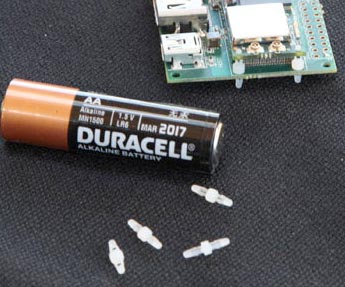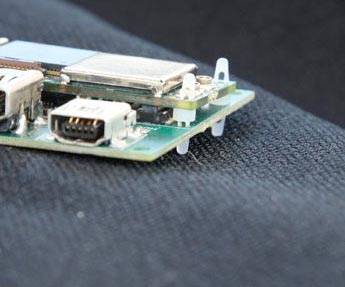
DuoVero Series
Gumstix's dual-core product COM series powered by the OMAP4 Digital Video Processor (Texas Instruments) with Cortex-A9. Find the product roadmap, videos, I/O design information, 2D layout and 3D models, expansion board schematics, vibration testing results and more.
For detailed hardware design information about the DuoVero series, download the DuoVero System Reference manual.
DuoVero Series Overview
The DuoVero series packs a lot of computing power in a tiny package.
In this section, you'll be introduced to:
-
The hardware of the DuoVero series.
- Linux and our User Wiki.
- Yocto - which is the "build environment" for writing code and developing an application using DuoVero products.
If you do not need an overview and just want to get started setting up your Gumstix system, then jump ahead to the "Getting started" section.
Introductory Videos
Gumstix has posted a series of videos that provides an introduction to the features and set up of several Overo and DuoVero configurations.
Hardware Introduction to the DuoVero series
The products in the Gumstix DuoVero series are divided into two areas:
- The computer-on-module or "COMs", which are smaller than the size of your index finger.
- The dual 70-pin expansion boards which provide the connectors needed for I/O functions such as USB, power input, LCD and HDMI and more. Each expansion board is the same size or bigger than the DuoVero COM so that there is room for the various connectors and I/O thru-holes and perhaps to fit around the LCD panel.
Each Gumstix DuoVero COM can fit on every expansion board of the DuoVero series. Note that the Gumstix DuoVero series is NOT compatible with any products of the Gumstix Overo series.
Despite the small size, a Gumstix DuoVero COM and expansion board combination performs like a full-sized, Linux computer and can be programmed to perform a wide variety of functions in almost any application area including power management, time & attendance, security, access control, information technology, location tracking, medical, aviation, robotics and education, to name a few.
The main features of a DuoVero COM include:
- Texas Instruments OMAP4430/4460 applications processor featuring the ARM® Cortex™-A9.
- Package-on-Package (POP) memory: up to 1GB RAM
- Bluetooth / 802.11b/g wireless communications module (optional) microSD card slot.
- Robust, 70-pin connectors on the lower side to bring out 140 signals from the OMAP4 processor
- Four (4) mounting holes - one in each corner.
- 17 mm x 58 mm.
- 6 grams.
Product information for each DuoVero computer-on-module is posted on their respective product pages at
Each DuoVero COM also brings a wide selection of signals to the two 70-pin connectors located on the bottom of the computer-on-module. The details of the assignment of signals and pin numbers for each of the two 70-pin connectors are posted in the Duovero System Reference.
A list of the expansion boards for the DuoVero series is available at www.store.gumstix.com.
Openly Published Schematics of Each Expansion Board
To assist customers in development of their a custom expansion board(s) compatible with and driven by a DuoVero COM, Gumstix makes the schematic of each expansion board available freely and without cost or licensing fees, via our website at pubs.gumstix.com.
Secure Mechanicals
Each DuoVero COM and expansion board configuration can·be secured together using either the white or the blue, plastic retaining spacers that Gumstix has made available in the accessories section of www.gumstix.com, linked here. Each DuoVero COM has a 0-80 mounting hole in each of the four corners of the Dvero COM for securing the COM to the expansion board.
DuoVero Design Overview
Robust Mechanical Design and Small Form Factor
The more powerful Gumstix DuoVero product line builds on the success of the mechanical design that was developed by Gumstix Engineering for the Gumstix Overo series.
Each Gumstix DuoVero COM can be used in robust, hand-held and portable applications. It's tiny, powerful and robust:
- A computer-on-module the size of the small finger: 58mm long x 17mm wide x 4.2mm high = 2.28 inches x 0.67 inches wide x 0.16 inches.
- Dual-core ARM Cortex-A9 processing at 1GHz with 1GB RAM.mi
- Connects to any expansion board of the DuoVero series or a custom-made expansion board.
- A pair of robust, 70-connectors bring out 140 signals, including the camera signals, on the lower side of the DuoVero COM to mate with an off-the-shelf Gumstix expansion board or custom-build your own expansion board to suit, using the openly published expansion board schematics.
Connectors on each DuoVero COM
The bottom surface of each DuoVero COM has two (2) x 70-pin Hirose DF40 connectors: (J1) and (J2). Each connector has the same signal pattern as every other DuoVero COM. See the DuoVero System Reference for more information.
Note: The DuoVero series is NOT compatible with the Overo series, as a different set of signals have been brought out on the dual, 70-pin connectors than in the Overo series. Refer to the System Reference documents, available as a PDF download from the main page of this Developer Center.
2D and 3D CAD drawings have been posted by Gumstix in the COMs section of pubs.gumstix.com to assist the design process of a custom enclosure or mounting assembly for a DuoVero-based configuration.
Signals
The signals and pin numbers of Connector J1 and Connector J4 have been detailed with the Duovero System Reference.
The Gumstix DuoVero COM delivers ARM Cortex-A9 computing power, up to 1GB of RAM, a microSD card slot and, optionally, wireless communications in this very small and robust form factor.
Based on a common mechanical footprint and a pair of robust 70-pin connectors, any model of DuoVero COM can be mounted on any DuoVero-series expansion board or to a compatible custom-designed expansion boards. The selection of features in openly-available designs includes HDMI, MIPI-compliant camera and display interfaces, Ethernet, USB Host, USB OTG, USB console, stereo audio, a power input jack and breakouts for A/D, GPIO, SPI, PWM, I2C, and 1-wire.
Figure 1 shows the main components of a DuoVero COM which includes a Texas Instruments OMAP™ applications processor (ARM® Cortex™-A9 core), package-on-package (PoP) stack memory, a TWL6030 power management module, a TWL6040 audio codec, interface ICs, and an optional Wi-Fi™ and Bluetooth™ module.

Performance and Power
Reliability and Benchmark Information.
DuoVero Reliability and US MIL-STD-810F Testing
Secure Mechanicals
Each DuoVero COM and expansion board configuration can·be secured together using either the white or the blue, plastic retaining spacers that Gumstix has made available in the accessories section of www.gumstix.com, linked here. Each DuoVero COM has a 0-80 mounting hole in each of the four corners of the Dvero COM for securing the COM to the expansion board.
The bottom surface of each DuoVero COM has dual, 70-pin Hirose DF40 connectors: (J1) and (J2). Note that these connectors differ from the dual, 70-pin AVX connectors used as inter-board connectors on the Overo COMs.
Shocking and Vibration Testing
Testing of a DuoVero configuration to the US MIl Spec 810.F tests for both shock and vibraton has not yet been completed.
Design and Production
Design and production reference information to help you create DuoVero-based products.
Retaining Spacers
The retaining spacers provide additional inter-board bonding between a DuoVero or Overo COM and an expansion board. These spacers can be used in applications of high mobiity and vibration. Results from a Gumstix customer testing to the US MIlspec for constant acceleration have been posted above.
Four spacers can be mounted on each DuoVero or Overo COM: one in each corner,
Gumstix supplies four retaining spacers with each DuoVero COM and Overo COM purchased at www.gumstix.com. Retaining spacers must be listed separately in a volume order.
The white or blue spacers can be purchased in a 50-pack via the Accessories section of www.store.gumstix.com.


Version Control and Lot Tracking
There are three aspects to define a hardware revision: the Fab, the Assembly, and the Lot. Every Gumstix COM and expansion board carries a white label with identification numbers to allow tracing of the build version and manufacturing history of that product.
The Fab Number
The "Fab" is the word Gumstix uses to name a particular "bare PCB" and the "Fab number" corresponds to one product type. For example, all Summit expansion boards have the Fab Number PCB30001 printed on the board in ink when the Fab was created. They also have a Revision number immediately following the PCB30001, such as -R2450
Fab numbers of Gumstix COM boards start with "PF"
- e.g. PF3503-R2606 defines bare PCB version 2606 of an Overo COM (PF3503)
Fab number of Gumstix Expansion boards start with "PCB"
- e.g. PCB30005-R2467 defines bare PCB version 2467 of a Chestnut expansion board (PCB30005)
Note that one or more products may be built on the same fab, depending upon which assembly (bill-of-materials) is used in manufacturing; e.g. two products with the same PCB layout and different component populations.
Assembly and Lot Codes
An Assembly describes a particular populated PCB and the Assembly number corresponds to one bill of material populating each of the different reference locations on the bare PCB. As of July 2010, Gumstix has requested that its manufacturers label every assembled board with a small white sticker carrying the following information:
- The Assembly number
- COMs begin with "GS" e.g. GS270B-XM4-R2635 defines assembly version 2635 of a verdex pro COM (GS270B)
- Expansion boards begin with "BRD" e.g BRD30001-R2563 defines assembly version 2563 of a Summit expansion board (BRD30001)
- The Lot number defining the particular work-order (build) of the specific assembly e.g. W/O #69217
- the Date code to define the date of assembly of that specific board --- e.g. "BT-10-26" to define the manufacturer code ["BT"] and year ["10"] and week of the year ["26"].
Note that some vendors have chosen alternative forms of the date code to correspond to their own manufacturing process, or to append their internal work-order number as well.
Product Features and Functions
To know what function is shipping on any particular Gumstix product, review the "Features" information as presented on the product page at www.gumstix.com rather than depending upon the function designed into the schematic posted in pubs.gumstix.com. Gumstix makes this recommendation because function designed on to a Gumstix board (as per schematic) may or may not be populated during the build process.
Keep-outs and Height Restrictions for a Custom Expansion Board
Layout information to aid design of a custom expansion board that would connect to a Gumstix DuoVero COM is planned to be available in the DuoVero System Reference manual.

